Related Research Articles

Tripura is a state in Northeast India. The third-smallest state in the country, it covers 10,491 km2 (4,051 sq mi); and the seventh-least populous state with a population of 3.67 million. It is bordered by Assam and Mizoram to the east and by Bangladesh to the north, south and west. Tripura is divided into 8 districts and 23 sub-divisions, where Agartala is the capital and the largest city in the state. Tripura has 19 different tribal communities with a majority Bengali population. Bengali, English and Kokborok are the state's official languages.
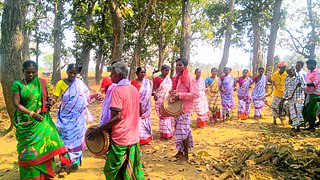
The Santal are an Austroasiatic-speaking Munda ethnic group of the Indian subcontinent. Santals are the largest tribe in the Jharkhand and West Bengal in terms of population and are also found in the states of Odisha, Bihar, Assam and Tripura. They are the largest ethnic minority in northern Bangladesh's Rajshahi Division and Rangpur Division. They have a sizeable population in Nepal. The Santals speak Santali, the most widely spoken Munda languages of Austro-asiatic language family.
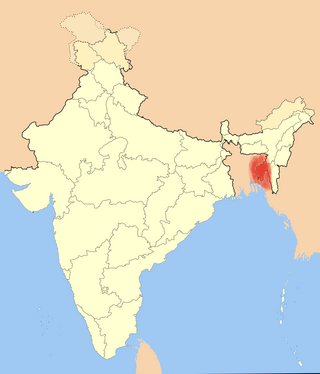
Kokborok is a Tibeto-Burman language of the Indian state of Tripura and neighbouring areas of Bangladesh. Its name comes from kok meaning "verbal" and borok meaning "people" or "human", It is one of the ancient languages of Northeast India.

The Tripuri are a Tibeto-Burman-speaking ethnic group of Northeast Indian state of Tripura. They are the descendants of the inhabitants of the Twipra/Tripura Kingdom in North-East India and Bangladesh. The Tripuri people through the Manikya dynasty ruled the Kingdom of Tripura for ~450 years until the kingdom joined the Indian Union on 15 October 1949.

Kokborok (Tiprakok/Tripuri) is the native language of Tripuri people in present Tripura state in Northeast of India. During the 20th century many of Royal family and its officials contributes to develop the Kokborok language in many ways.
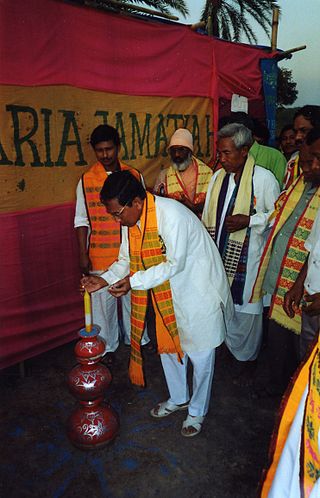
Jamatia Hoda is the institution that looks after the rights and safeguard of the culture of the Jamatia clan of Tripuri community. It has head-office in Atharobla in Udaipur town of South Tripura district of Tripura and a branch office at Khejurbagan, Agartala near Sri Krishna Mission School. It has also started a higher secondary school named Garia Academy. in Atharobla. It is affiliated to CBSE board.
Reang is one of the Tripuri clan of the Northeast Indian state. The Reangs can be found all over the Tripura state in India. However, they may also be found in Assam and Mizoram. They speak the Kokborok language.
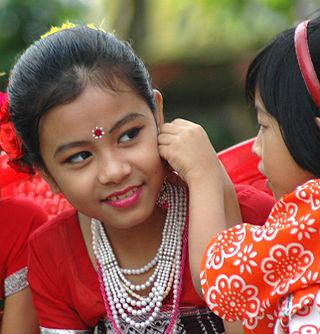
The Tripuri culture of North-East India has many distinctive features.
Nador (ನಾಡೋರ) or Nadavaru or Nadavar (ನಾಡವರ) is the name of a caste from Karnataka, India. Members of the castle are found primarily in the coastal areas of Uttara Kannada district, formerly known as North Canara, with many members also spread throughout the world. Caste members traditionally speak the Nadavar dialect of Kannada called Nadavar Kannada. They are a prominent agriculture community of the Uttara Kannada district of Karnataka, India.
The indigenous people of Bangladesh are ethnic minorities in Chittagong Hill Tracts (southeastern), Sylhet Division (northeastern), Rajshahi Division (west), and Mymensingh Division (north-central) areas of the country. They are indigenous and the tribal races, total population of ethnic minorities in Bangladesh was estimated to be over 2 million in 2010. They are diverse ethnic communities including Tibeto-Burman, Austric and Dravidian people.
The Kupari consist of Kadodi Christians and Samvedi Christians, which are a Roman Catholic Brahmin sub-group in the Christian Bombay East Indian community, of the people of Konkan division. They are concentrated mostly in Bassein (Vasai), India, which is about 60 kilometres (37 mi) north of Mumbai (Bombay) city. Kadodi ancestors were a mixture of Samvedi Brahmins, Goan Konkani Brahmins& Portuguese New Christians; because of intermarriages between them. The population is about 40,000 to 45,000. The two Konkani dialects spoken by the Kuparis are Samvedi Boli Bhasha and Kadodi, which are a mixture of Gujrati, Marathi & Indo-Portuguese. 97% of the population is Roman Catholic and the remaining minority is a mixed population of various Protestant Revolutionary denominations.

The Kisan are a tribal group found in Odisha, West Bengal and Jharkhand. They are traditional farmers and a food gathering people. They speak Kisan, a dialect of Kurukh, as well as Odia and Sambalpuri. The tribe mainly lives in northwestern Odisha, in the districts of Sundergarh, Jharsuguda and Sambalpur. Other populations live in Malda district in western West Bengal and Latehar and Gumla districts of western Jharkhand. They also reside in Nepal's Jhapa district in small number(around 1000).
Guptan is a Hindu forward community from the Palakkad district of Kerala, South India. The majority of the Guptans are located in Valluvanad, with major agglomerations around Vayillyamkunnu, Kadampazhippuram, Sreekrishnapuram, Chethallur and Mannarkkad. Many Sanskrit scholars and popular astrologers originated from this community.
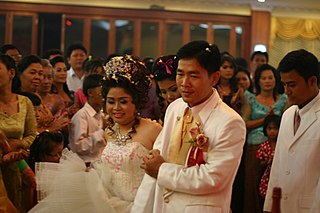
Courtship, marriage, and divorce in Cambodia are important aspects of family life. Customs vary as between rural and urban areas, with many city dwellers being influenced by western ideas. The choice of a spouse is usually undertaken by the families of young men and women, sometimes with the help of a matchmaker. A man usually marries between the ages of nineteen and twenty-five and a woman between sixteen and twenty-two.

The Konjo, BaKonzo, or Konzo, are a Bantu ethnic group located in the Rwenzori region of Southwest Uganda in districts that include; Kasese, Bundibugyo, Bunyangabu and Ntoroko districts.

The Azerbaijani wedding tradition is one of the most significant and solemn family traditions of Azerbaijani people. It is multi-stepped, and is related to various compulsory rituals and traditions. Ancient Azerbaijani weddings reflect cycles of traditions, lasting for a long period of time, and need significant material costs.

The 2003 Nisha Sharma dowry case was an anti-dowry lawsuit that has been cited as an illustrative example highlighting the potential for misuse of the IPC 498A law in India.
Sudhanwa Debbarma was an Indian Kokborok writer, Political leader and member of the Communist Party of India (Marxist). He was the former Speaker of Tripura Legislative Assembly. He was the veteran leader of Ganamukti Parishad. He was a member of Tripura Legislative Assembly from Takarjala (1977-1988).
The Kaikadi are a community in the Indian states of Maharashtra and Karnataka. Their name is derived from kai and kade, while the community derives its name from kai and kadi. Traditionally, they were nomadic, mainly wandering in the Vidarbha region of the state, but most have now settled down. They speak Kaikadi, a Dravidian language closely related to Tamil with significant Indo-Aryan admixture. They practice the puberty function like other Tamil communities.
References
- ↑ "Murasing in India". Joshua Project.
- ↑ Deb, Debraj. "Tripura rechristens two hill ranges with Kokborok names". The Indian Express.